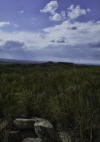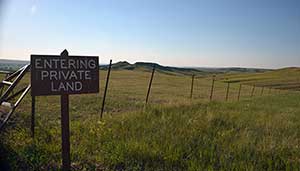| Friends Of The Little Bighorn Battlefield |
The Next Generation In The Study Of Custer's Last Stand |
Unraveling Riddles in the Shadow of Sharpshooter Ridge With Michael Donahue
|
| • The Battle • Archeology • Memorials • Little Bighorn Store • News • Book Reviews |
"Unraveling Riddles in the Shadow of Sharpshooter Ridge" With Michael DonahueBy Mike Semenock, Friends Board MemberAll photos © Bob Reece unless otherwise noted "He died right here; right where I’m standing. He’d
shot three men of Company M as they lay prone 600 yards away and below him,
where the routed soldiers were now surrounded. He must have smiled after each
shot before once again turning stony-faced as he peered down the sights of his
rifle. Suddenly eight bluecoats sprang up, turned his way and fired, and the
warrior fell silent.
Back this year, this time the sole leader of our field trip, was Park Ranger and Little Bighorn Battle Historian Michael Donahue. When not speaking to spellbound summer audiences at the battlefield Visitor Center, Donahue is a college art professor and department chairman, artist and author. His first book, “Drawing Battle Lines-The Map Testimony of Custer's Last Fight" was published in 2008 by Upton and Sons. On this balmy evening, as we ambled along Sharpshooter Ridge, Donahue presented a unique analysis of battle events that substantiate the provocative theories to be divulged in his next book.
Michael Donahue beside his maps and the rock cairn on Sharpshooter Ridge, Reno Benteen Battlefield in distance
Reno-Benteen defense area from Sharpshooter Ridge Wolf Mountains in distance Because the crowd of more than sixty was to assemble where there is no parking, participants were transported by tour bus in two runs from the Visitor Center to a pull-out below Sharpshooter Ridge. When the bus arrived with the second group, they filed out the door, joined the first riders and spread along the shoulder of the loop road. As we began the ascent, spread out behind him, Donahue suggested we narrow up. “If you form a skirmish line, you’re bound to find a rattlesnake. Form a line and let those in front find them,” he quipped.
The line walking up to Sharpshooter Ridge Donahue stopped to begin his talk and the attentive crowd spread out, eyes on the
ground, treading cautiously, and gathered around him. For the next hour he
tantalized us with tidbits of primary accounts regarding the battle and its
aftermath. He’d pull his audience into the discourse with thought provoking
questions and challenge them to reconsider generally accepted assumptions. I
can’t replicate here the experience or the presentation, but I can relate a few
particulars. Suffice it to say I came away eager to get hold of that new book.
(Webmaster Note: As of this writing, there is no publication date set for Mr.
Donahue's book)
The valley beyond the Reno-Benteen
defense area Atop the ridge Donahue stopped by a small rock cairn. Another, farther north along
the ridge, was not far away. They could mean warriors died at these spots,
Donahue
said, or perhaps the rock piles were used as breastworks. “But,” he continued,
“the only known photo of an Indian reenacting a sniper here shows him using
crossed sticks as a rifle rest.” They sure looked like the other cairns
commemorating a warrior’s death to me, I thought.
Looking south up the Little Bighorn valley as seen from Sharpshooter Ridge. The bluffs on the east side of the river hid the Indian village from Custer's view
Panoramic of north end Sharpshooter
Ridge, and Weir Point.
According to an Arikara scout named Soldier, here Custer took off his buckskin
coat and put it on the back of his saddle. Custer then rallied the troops with a
wave of his hat and shouted, “We’ve caught them napping, boys! Let’s finish up
and return to our station.” Soldier soon went back and did not continue with
Custer, but he left us this great eye witness account of the men getting ready
to go into a fight, “The men began throwing away their hats and wrapping their
heads with bandanas.” "For the next hour he tantalized us with tidbits of primary accounts regarding the battle and its aftermath." Donahue seen in the center
Melani Van Petten and others on Sharpshooter Ridge
It was Curley who said that Custer’s command traveled down Cedar Coulee from the
bluffs and Martin, forgetful or lying, agreed with him. However, in the years
following, Curley’s story would change time and again, and his maps were
different each time he made one. Henry Weibert said metal detector surveys of
Cedar Coulee found no evidence to support this version of the events. Other
accounts have the trail going through the saddle of Weir Point (since cut out by
the road) and down the slope of the bluffs. In an unpublished letter, French
said Custer’s trail went over the saddle of the high ground, meaning the swale
between the heights of Weir Point. “So,” Donahue said, “if you take Curley’s
account out of the equation, all these other accounts begin to make sense.” "Custer's trail went over the saddle of the high ground."
Toward the end of Donahue’s talk, the crowd perked up when he said, “A soldier in
buckskin was killed at the river and it wasn’t Custer.” As we started down the slope to return to the tour bus, Melani Van Petten - who could have been speaking for all of us - told Donahue, “You made my day.” Carol Near, Nancy Marteney, Joanne Blair, and a well-hidden Jim Thorn on the tour bus heading back to the visitor center. "What a great field trip!"
2015 Summer EventsSummer Events Home |
|
Copyright 1999-2016 Bob Reece Friends Little Bighorn Battlefield, P.O. Box 636, Crow Agency, MT 59022 | Home |
Board of Directors |
Guest Book | Contact | Site Map
| |










